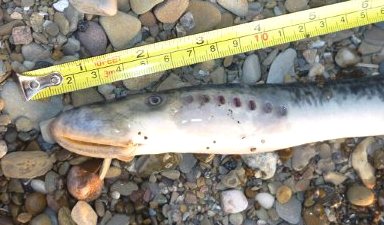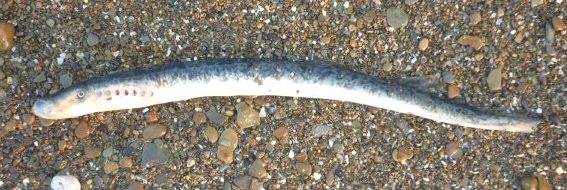Sea Lamprey
(Petromyzon marinus)


Sea lampreys are the only non-native lamprey species in Ohio that are a potential threat to sport fishes. The other 6 species of lamprey found in Ohio are native and pose no threat to sport fish population.
Description
All lampreys have a long eel-like body and no scales. They have segments of muscles that are visible along their body called myomeres, and a jawless mouth. In larval lampreys, called ammocoetes, their mouth is not fully developed, very small, and hidden between folds of skin. Adults have a disk shaped mouth with varying amounts of teeth depending on the species. The sea lamprey has a deeply notched dorsal fin, separating it into two distinct parts. They have 63-80 myomeres (muscle segments) between the last gill opening and the anus. The disc like mouth of the adults contains large sharp teeth on the entire disc. Adults are dark tan above and lighter below with many darker speckles or blotches prior to spawning. During spawning, adults become blue-black in color. The sea lamprey is most similar to the Ammerican brook lamprey and least brook lamprey in Ohio. These species are much smaller (never reaching more than 8 inches), lack the darker blotches or mottling on the body, and are non-parasitic. All other Ohio lamprey species have only a single long dorsal fin.
Habitat and Habits
All parasitic lampreys required three distinctly different habitats that are connected by free flowing (free of dams) stretches of streams. Spawning adults are found in clear brooks with fast flowing water and either sand or gravel bottoms. Juveniles or ammoccoetes are found in slow moving water buried in soft substrate of medium to large streams. Non-spawning parasitic adults are found in large bodies of water (Lake Erie or the Ohio River) with abundant populations of large fish. Sea lampreys were not found in Ohio historically. After the construction of the Welland Canal in 1829, which created a passage around Niagara Falls for ships and fish alike, they could have been present in Lake Erie. However, none were found in Ohio waters of Lake Erie or its tributaries until 1927. Since then this non-native lamprey has increased in numbers but is much less abundant in Lake Erie than the rest of the upper Great Lakes where it has done significant damage to sport fish populations. This species is only found in Lake Erie and its tributaries in Ohio.
Reproduction and Care of the Young
Sea lampreys spawn in late May or early June in shallow pits that are excavated near the upper ends of gravel riffles. These pits are created communally by several individuals constructing one pit. They use their suction cup like mouth to move stones away to form the pit. Females then deposit many eggs in these pits. After hatching, the ammocoetes (larval stage of lampreys) drift down stream to larger slower moving streams and burrow into the sediment. During this phase, they eat organic particles strained from bottom sediments and the water, as well as microscopic organisms. After several years, the ammocoetes transform into a parasitic adult in spring. Adults migrate into the Lake Erie and feed on other fish. The following spring they migrate into tributary streams spawn and then die shortly after.